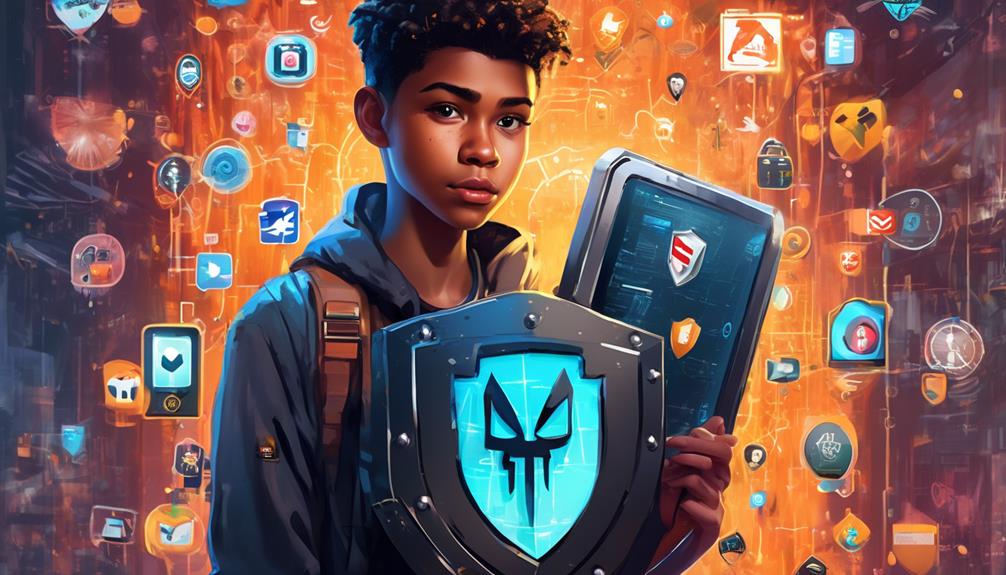Cyber safety programs for teens are increasingly vital, given the rise of online threats. These young individuals are navigating a world where their online and offline lives merge. They face unique challenges, unlike those their parents experienced. Therefore, cyber safety programs are designed to provide teens with essential protective tools and knowledge.
Moreover, these programs encompass various topics. They teach understanding cyber threats, managing digital footprints, and navigating social media safely. Despite their prevalence, there are still questions regarding their effectiveness. Additionally, customization is needed to meet teenagers' diverse needs.
In analyzing these programs, we must consider the proper balance. It's crucial to educate teens while also creating a trusting and safe online environment.
Understanding Cyber Threats

Navigating the digital landscape requires vigilance, especially for teens. They must recognize and understand the ever-evolving cyber threats to their online safety. In this connected world, teens are not merely users. They actively participate, with personal security depending on their digital danger awareness. Hence, mastering password security is crucial for them.
Complex and unique passwords serve as a fundamental defense. They prevent unauthorized account access effectively. Additionally, virus prevention is an essential element of cyber hygiene. Teens need knowledge to avoid malicious software downloads. They should also grasp the importance of regular device updates.
Security patches are vital for maintaining system integrity. Teens must be cautious, as a single click can jeopardize their data. Such an incident may trigger a cascade of security breaches.
Identifying Personal Scams
Teens must stay alert to the deceptive lures of personal scams, which often disguise themselves as legitimate offers or urgent requests. In the digital age, scammers relentlessly target young individuals, exploiting their desire for connection and belonging. To fend off these threats, teens should be equipped with knowledge about scam red flags and victim support mechanisms.
Here are three critical pointers to help identify and avoid falling prey to personal scams:
- Unexpected Requests: Be wary of unsolicited messages asking for personal information or money, even if they seem to come from friends or family. Scammers can mimic familiar contacts to create a false sense of security.
- Too Good to Be True: If an offer seems too enticing, like winning a contest you didn't enter or receiving exclusive discounts, it's likely a scam. Authentic organizations don't typically give away valuable prizes or services without a clear reason or a prior relationship.
- Pressure Tactics: Scammers often create a sense of urgency, pushing you to act quickly. Take a moment to assess the situation and talk to someone you trust before making any decisions.
Digital Footprint Awareness

Understanding one's digital footprint is essential for online privacy and reputation. Indeed, each internet action can create a lasting impact. Cyber safety programs highlight the need for teen awareness about their digital trails. Consequently, these programs educate about the influence of posts, comments, and interactions.
Teens learn that their digital footprint is a data trail and an identity mosaic. This mosaic can affect college admissions, job prospects, and relationships. It's crucial to connect online shares with others' perceptions. Thus, teens should ensure their online presence mirrors their best qualities.
Search consequences are undeniable; content linked to a name reflects that person's character. Therefore, cyber safety programs stress the importance of privacy settings and careful sharing. These are tools for teens to shape their online narrative.
Teens are reminded they're part of an online community. As such, their positive contributions are vital. They must recognize that their current actions can resonate far into their future.
Safe Online Communication
Teens should recognize online dangers, as threats hide behind anonymity. Consequently, they must establish strict privacy boundaries. Personal information should only be shared when it's unequivocally safe. Thus, they safeguard against cyber predators and control their internet footprint.
Recognizing Digital Risks
Navigating the digital world, adolescents must identify and comprehend the numerous risks of online communication. To ensure a safe environment for teens, it's critical that they learn the value of:
- Parental Controls: By implementing these tools, parents can monitor and restrict access to harmful content, offering a protective layer.
- Device Security: It is essential for personal devices to be kept secure, thereby preventing unauthorized access to private information.
- Phishing Scams: Teens should recognize suspicious messages and emails to protect their digital identities from cybercriminals.
Furthermore, teens seeking online belonging need to be mindful of their digital footprints. Awareness of these risks and taking proactive cybersecurity steps allow teens to engage in online communication with confidence and safety.
Establishing Privacy Boundaries
Recognizing digital risks is crucial. Equally important, however, is for adolescents to establish firm privacy boundaries. As part of a connected community, teens often share freely. Yet, it's vital they learn to set sharing limits.
Personal information is akin to currency online. Therefore, it should be guarded with utmost care. Cyber safety programs teach teens critical questioning. They learn what to share, with whom, and the frequency.
Sensitive data such as addresses, phone numbers, and financial details should remain private. Consequently, this helps teens forge a secure online identity. By adopting these practices, teens can safely enjoy the digital world. They stay protected against its inherent vulnerabilities.
Privacy Protection Strategies

Understanding how to safeguard personal information online is a crucial skill for young people in today's digitally interconnected world. Privacy protection strategies are essential to ensure that teens can navigate the internet safely and confidently. Here are a few key tactics:
- Data Encryption: Teens should learn about the importance of data encryption, a method that protects information by converting it into a code to prevent unauthorized access. They're encouraged to use encrypted messaging apps and secure websites, identified by HTTPS in the URL, to keep their conversations and data private.
- Cookie Management: Understanding and managing cookies is another vital step. Cookies can track online behavior, so teens need to know how to clear them regularly and set their browsers to limit cookie use. It's not just about pressing 'accept' on every pop-up; it's about making informed decisions on which cookies to allow.
- Strong Passwords and Two-Factor Authentication: Creating robust passwords and enabling two-factor authentication adds an extra layer of security. Teens should use a mix of letters, numbers, and symbols in their passwords and activate two-factor authentication where available to make it harder for unauthorized users to gain access to their accounts.
Social Media Safety Practices
Building on the foundation of privacy protection, teens must also adopt vigilant social media safety practices to further secure their online presence. In the ever-connected world of likes and shares, it's crucial that they understand the importance of friend vetting. This isn't about excluding peers; it's about creating a trusted circle that respects each other's digital boundaries. Teens should be encouraged to connect only with individuals they know and trust in real life, reducing the risk of exposure to potential online predators or cyberbullies.
Moreover, they should exercise hashtag caution. Hashtags can inadvertently link posts to public, broader conversations, attracting unwanted attention or revealing personal information to strangers. Teens aspiring to be part of the in-crowd need to know that it's not just about getting noticed—it's about staying safe while being seen.
Engaging Cybersecurity Courses

To ensure teens have strong online defenses, engaging cybersecurity courses offer interactive lessons. These lessons captivate young minds and teach crucial digital safety skills. The courses aim to create a community feeling, preparing informed digital citizens for online challenges.
Notably, these courses are unique due to several features:
Firstly, they include Interactive Challenges. Learners actively participate, tackling real-world scenarios that test their cybersecurity knowledge and quick thinking. Secondly, there is Hackathon Participation. This allows teens to experience the excitement of hackathons, working with peers to solve issues and devise innovative security measures. Thirdly, students receive Hands-On Encryption Basics training. They learn to safeguard information and grasp secure communication's significance.
Educators are committed to making these courses both informative and deeply engaging. They recognize the power of belonging to a group that's acquiring vital life skills. Consequently, they incorporate activities like hackathons that align with teens' interests. This approach keeps them engaged and invested in their cyber safety.
Frequently Asked Questions
How Can Parents Effectively Monitor Their Teen's Online Activities Without Invading Their Privacy?
Parents can set up parental controls to balance oversight with privacy. Additionally, fostering trust through dialogue about online activities is crucial. Importantly, ensuring teens are involved in decision-making helps maintain their sense of autonomy.
What Legal Steps Can Be Taken Against Cyberbullies or Online Harassers Targeting Teens?
Parents seeking justice for their child can report cyberbullies to authorities. Consequently, harassers may face charges, fostering a safer online space for teens.
Are There Specific Mental Health Resources Available for Teens Coping With the Stress and Anxiety of Cyber Threats?
Indeed, there are mental health resources aimed at teens. These provide digital resilience support with counseling networks. Additionally, they offer strategies to combat stress from cyber threats, guaranteeing teens are not isolated in their struggles.
How Can Teens Balance the Benefits of Technology With the Potential for Addiction and Overuse?
Teens often dedicate more than seven hours a day to screen time, which poses a risk of addiction. Consequently, they seek equilibrium by practicing digital detoxes and using devices with intention. This approach fosters community, as they strive to interact with technology in a responsible and significant manner.
What Roles Do Schools Play in Complementing Cyber Safety Programs, and How Can They Integrate These Lessons Into Their Curricula?
Schools play a crucial role in promoting digital literacy. Consequently, they integrate cyber safety within their curriculum development. Importantly, they teach students responsible technology usage. Moreover, they nurture a sense of belonging in today's digital community.
Conclusion
In conclusion, with 95% of teens online daily, cyber safety programs are essential. Consequently, these programs provide vital protection. They equip teens with essential tools for digital navigation. This includes strategies for avoiding scams and managing digital footprints. Additionally, they foster safe communication habits. By teaching privacy strategies, they also promote smart social media use. Teens, therefore, become skillful digital citizens. Engaging cybersecurity courses are informative. More importantly, they empower teens. Teens can confidently control their online presence. They maintain vigilance in their online interactions.



